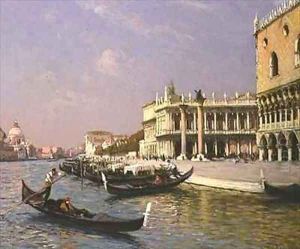Gaston Hippolyte Boucart Paintings
Gaston Hippolyte Boucart was a French painter born in 1861, whose work spanned the late 19th and early 20th centuries. His oeuvre is characterized by its diversity, encompassing a variety of genres including landscapes, seascapes, still lifes, and portraits. Boucart's artistic journey reflects a rich tapestry of influences and a profound connection to the natural world, as well as an interest in capturing the essence of his subjects with both realism and emotional depth.
Educated in the fine arts during a period of rich artistic innovation in France, Boucart was exposed to the evolving trends of Impressionism and Post-Impressionism, which subtly influenced his approach to painting. However, he maintained a distinctive style that was rooted in a more traditional aesthetic, often emphasizing the beauty of the French countryside and coastlines. His landscapes and seascapes are particularly noted for their detailed texture, vibrant color palette, and the ability to evoke the atmosphere of the scenes depicted.
Despite his considerable talent and the quality of his work, Gaston Hippolyte Boucart never achieved the same level of fame as some of his contemporaries. His art, however, has been appreciated for its craftsmanship and the serene beauty it captures, inviting viewers into a world of tranquil scenes and harmonious compositions. Boucart's dedication to his art continued throughout his life until his death in 1945. Today, his works are held in private collections and occasionally appear in exhibitions focusing on French art of the late 19th and early 20th centuries. Boucart's legacy is that of a skilled painter who, despite the shifting tides of artistic fashion, remained true to his vision, crafting works of enduring beauty and tranquility.
